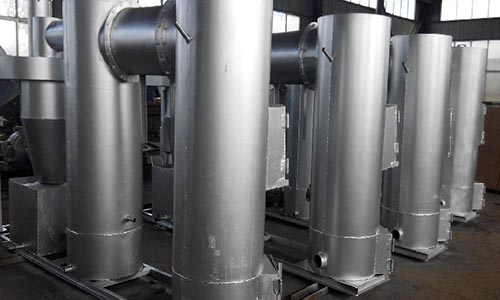Garbage Incinerator Introduction
Garbage incineration is the most effective method to propose household garbage. High temperature incineration can decompose harmful components in garbage, main factors affecting the process efficiency are incinerating temperature, staying time, air quantity and garbage calorific value.
Incineration Temperature
Incineration temperature is the temperature at which toxic components in garbage are oxidized, decomposed and totally destroyed. It is much higher than the kindling temperature of the garbage. Incineration temperature is important parameter for the design of incinerator lining structure and for the choosing of refractory material.
Generally, increasing incineration temperature is good for the decomposition of toxic component in garbage, it can also reduce the amount of black smoke. But, over-high temperature will consume more fuel and will increase quantities of volatile metals and nitrides, which can cause secondary air pollution. If the incineration temperature is low, the toxic components can not be totally decomposed or destroyed. So, incineration temperature is closely related to the staying time in incinerator.
Incinerator Models and Structures
Incinerator is main equipment for garbage incineration process, it can be divided into 3 models by combustion methods.
Fire Grate Combustion Incinerator
This type of incinerator mainly refers to box type furnace, which has simple structure. There is fire grate at the bottom of the furnace, it has the functions of supporting waste residue, ventilation and ash residue removal. The drying and incineration of waste residue rely on flame and furnace wall radiation. Fire grate combustion incinerator has fixed fire grate type and movable fire grate type.
Furnace Bed Combustion Incinerator
In furnace bed combustion incinerator, the waste is agitated and burned at furnace bed. This type of incinerators include rotary incinerator and multi-stage incinerator.
Space Combustion Incinerator(Fluidized Bed Incinerator)
No matter fire grate combustion or furnace bed combustion, block type or cluster type waste residue always contact with hot air current. As contact area is limited, thermal conductivity is very low, staying time have to be prolonged, which will cause the disadvantages such as low process capacity, incomplete incineration and so on. Process practice suggests that, the larger the surface coefficient of residue, the faster the drying and incineration of the waste residue. If the waste residue can be dispersed and suspended in hot air current, it can be dried and incinerated in very short time, therefore, fluidized bed incinerator.
Fluidized bed incinerator includes vertical cylindrical furnace made by steel shell, the inner lining is made by refractory bricks and insulating bricks, air current distribution board wit holes is set at the bottom of the furnace, carrier grains(usually silica sand) layer is paved on distribution board. High pressure hot air is blew form the underneath of the board to make the carrier suspend in the furnace hearth. Then waste residue is loaded into the incinerator by screw feeder, it mixes with carrier for the combustion. The fine ash after burning is discharged along with exhaust gas and is collected by ash separator.
The incineration temperature of fluidized bed incinerator is usually between 750~870℃. The temperature is controlled and regulated by auxiliary burner nozzle and preheated air temperature. Preheated air is supplied by hot blast furnace, the temperature of the preheated air depends on garbage water content and the calorific value of the garbage. For example, if the sludge contains 60% of water, air should be preheated to 300 ℃ for incineration, if water content is 55%, the air only needs to be preheated to 200℃.
The Characteristics of Fluidized Bed Incinerator
Waste residue is evenly dispersed by fluidized sand, so waste residue has large contact area with hot air current, thermal transmission speed is high, so unit furnace bed area has large process capacity(150~200kg/m3·h), the size of the process equipment can be minimized.
As the temperature is fluidized bed can keep between 750~870℃, there is little amount of bad smell in sludge incineration smoke, deodorization is not needed, and the investment is saved.
As the furnace has large volume heat load,(168~252*104kJ/m3·h), there is large tolerance for the variation of waste property and quantity. Different kinds of large water content sludge or even pure liquid can be incinerated. Meanwhile, the furnace has large heat storage capacity, temperature drop is slow when furnace is ceased, it is easy to restart the furnace, so intermittent operation can be carried out.
Has strong adaption to fuels, because it is not flare burning, low quality fuels ca be used.
The discharged exhaust can meet environment protection requirement, there is no secondary pollution.


